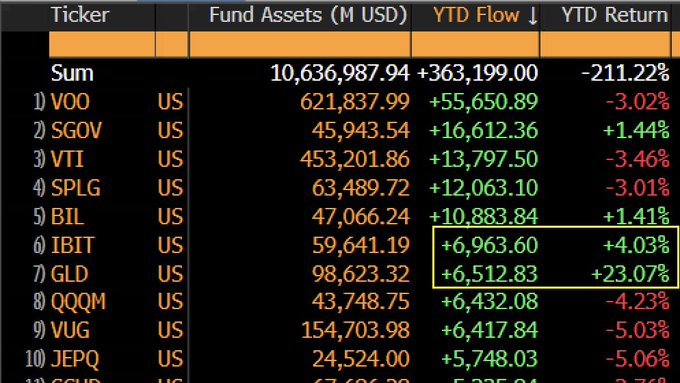Bitcoin Inflows Overtake Gold as U.S. ETF Investors Realign Portfolios in 2025



- Bitcoin ETFs saw higher inflows than gold despite lower returns in 2025.
- U.S. equity ETFs attracted strong inflows despite posting negative YTD performance.
- Short-term bond ETFs gained traction as investors sought safety amid market uncertainty.
Investor activity in U.S.-listed exchange-traded funds (ETFs) displays changing patterns in 2025, as total year-to-date (YTD) inflows reached $363.2 billion across funds managing $10.64 trillion in assets.
The standout observation comes from the digital asset segment, where the BlackRock iShares Bitcoin Trust (IBIT) has drawn in $6.96 billion so far this year. This total surpasses the $6.51 billion in inflows recorded by SPDR Gold Shares (GLD), the leading gold ETF.
The difference in investor behavior is particularly noteworthy given GLD’s 23.07% YTD return compared to IBIT’s 4.03%. The inflow data suggests that despite gold ’s outperformance, a growing portion of capital continues to be directed toward Bitcoin-focused products.
Large Equity Allocations Persist Despite Market Pullbacks
The Vanguard S&P 500 ETF (VOO) has recorded the highest inflows of $55.65 billion among all ETFs. This move comes amid a year-to-date return of -3.02%, indicating continued investor commitment to broad-market U.S. equities despite recent underperformance.
Other equity-focused funds like the Invesco QQQM ETF and the Vanguard Growth ETF (VUG) have brought in about $6.4 billion each and another $4 billion has gone into banks and bank stocks. However, both have fallen from value, with YTD decline of -4.23 percent for QQQM and -3.22 percent for VUG.

Source: X
The data points to ongoing interest in long-term exposure to the equity market, even during periods of volatility. Despite negative short-term returns, these flows suggest a preference for passive indexing and large-cap growth positions.
Short-Term Bond Funds Attract Risk-Averse Capital
In the fixed-income space, investors show renewed interest in short-duration Treasury products. The iShares 0-3 Month Treasury Bond ETF (SGOV) collected $16.6 billion in inflows with a 1.44% return, while the SPDR Bloomberg 1-3 Month T-Bill ETF (BIL) brought in $10.88 billion and delivered an identical return.
This defensive strategy is consistent with broader market uncertainty, where downside protection remains a priority for some investor classes. The JP Morgan Equity Premium Income ETF (JEPI) a fund that duplicates the option returns of an ETF but without actually using options, also saw $5.75 billion of inflows.
Its YTD return, however, is -5.06%. Investors have been looking for alternative ‘income’ streams, yet, at least, the performance figures suggest that these strategies haven’t met expectations in this cycle.

Bitcoin Hits $99,000, Indicating Growing Institutional Engagement and Investors’ Confidence
Bitcoin ($BTC) nears $99K with 44.7% volume surge, with rising market cap, and growing institutional...

Edge Matrix, CoLabs Partner to Fortify NFT Creators
The Edge Matrix and CoLabs partnership aims to strengthen non-fungible token (NFT) creators to conve...

NODO and daGama Redefine Physical World Commerce: Smart Locations, Smarter Infrastructure
NODO and daGama have revealed their strategic partnership to create new location-based services thro...

